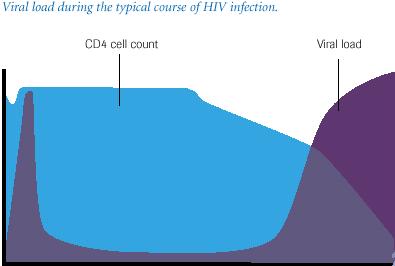HIV-1 viral load refers to the number of viral particles found in each millilitre of blood. The more HIV-1 viral particles in the blood, the faster the CD4 cells are likely to be destroyed and the faster the progress towards AIDS.
As can be seen in the graph below, the viral load and the CD4 cell count change over time in an HIV-1-infected person who is not being treated. When a person first becomes infected with HIV-1, the viral load rises, then falls as the body tries to fight the infection by producing anti-HIV antibodies. The CD4 cell count dips slightly at first, since the HIV-1 virus actually destroys these immune system cells, but returns toward normal. The length of time between initial infection with HIV-1 and the development of AIDS can vary from one person to another for reasons that no one fully understands. Although it may seem that nothing is really happening during this time, the body is fighting a tremendous battle to keep the virus under control — and it may succeed for several months, or even many years. Without treatment, however, most people infected with HIV-1 will have their CD4 cell counts decrease and their viral load increase again as the infection becomes more serious. This happens because the body can no longer keep the HIV-1 virus under control.

Combined with a CD4 cell count, the ability to measure HIV-1 viral load levels and monitor how they change over time has made it possible to:
- track how well the body is fighting HIV-1
- estimate the risk of developing AIDS
- judge the effectiveness of therapy.
Viral load is an important sign of how well the goal of therapy is being met: keeping the virus under control or suppressed for as long as possible.
|

